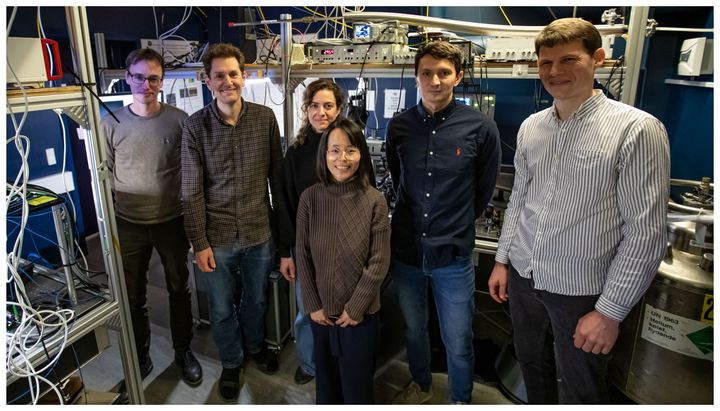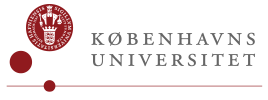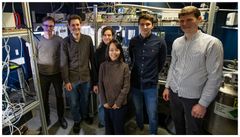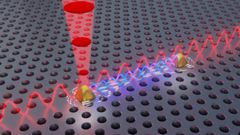Danish quantum physicists make nanoscopic advance of colossal significance

Going from one to two is a minor feat in most contexts. But in the world of quantum physics, doing so is crucial. For years, researchers around the world have strived to develop stable quantum light sources and achieve the phenomenon known as quantum mechanical entanglement – a phenomenon, with nearly sci-fi-like properties, where two light sources can affect each other instantly and potentially across large geographic distances. Entanglement is the very basis of quantum networks and central to the development of an efficient quantum computer.
Today, researchers from the Niels Bohr Institute published a new result in the highly esteemed journal Science, in which they succeeded in doing just that. According to Professor Peter Lodahl, one of the researchers behind the result, it is a crucial step in the effort to take the development of quantum technology to the next level and to "quantize" society’s computers, encryption and the internet.
"We can now control two quantum light sources and connect them to each other. It might not sound like much, but it’s a major advancement and builds upon the past 20 years of work. By doing so, we’ve revealed the key to scaling up the technology, which is crucial for the most ground-breaking of quantum hardware applications," says Professor Peter Lodahl, who has conducted research the area since 2001.
The magic all happens in a so-called nanochip – which is not much larger than the diameter of a human hair – that the researchers also developed in recent years.
Quantum sources overtake the world's most powerful computer
Peter Lodahl's group is working with a type of quantum technology that uses light particles, called photons, as micro transporters to move quantum information about.
While Lodahl's group is a leader in this discipline of quantum physics, they have only been able to control one light source at a time until now. This is because light sources are extraordinarily sensitive to outside "noise", making them very difficult to copy. In their new result, the research group succeeded in creating two identical quantum light sources rather than just one.
"Entanglement means that by controlling one light source, you immediately affect the other. This makes it possible to create a whole network of entangled quantum light sources, all of which interact with one another, and which you can get to perform quantum bit operations in the same way as bits in a regular computer, only much more powerfully," explains postdoc Alexey Tiranov, the article’s lead author.
This is because a quantum bit can be both a 1 and 0 at the same time, which results in processing power that is unattainable using today's computer technology. According to Professor Lodahl, just 100 photons emitted from a single quantum light source will contain more information than the world's largest supercomputer can process.
By using 20-30 entangled quantum light sources, there is the potential to build a universal error-corrected quantum computer – the ultimate "holy grail" for quantum technology, that large IT companies are now pumping many billions into.
Other actors will build upon the research
According to Lodahl, the biggest challenge has been to go from controlling one to two quantum light sources. Among other things, this has made it necessary for researchers to develop extremely quiet nanochips and have precise control over each light source.
With the new research breakthrough, the fundamental quantum physics research is now in place. Now it is time for other actors to take the researchers' work and use it in their quests to deploy quantum physics in a range of technologies including computers, the internet and encryption.
"It is too expensive for a university to build a setup where we control 15-20 quantum light sources. So, now that we have contributed to understanding the fundamental quantum physics and taken the first step along the way, scaling up further is very much a technological task," says Professor Lodahl.
The research was conducted at the Danish National Research Foundation's "Center of Excellence for Hybrid Quantum Networks (Hy-Q)" and is a collaboration between Ruhr University Bochum in Germany and the the University of Copenhagen’s Niels Bohr Institute.
Contacts
Peter Lodahl
Professor
Niels Bohr Institute
University of Copenhagen
Mobile: + 45 20 56 53 03
Email: lodahl@nbi.ku.dk
Alexey Tiranov
Postdoc
Niels Bohr Institute
University of Copenhagen
Phone: + 45 35 33 51 39
Email: alexey.tiranov@nbi.ku.dk
Michael Skov Jensen
Journalist and team coordinator
The Faculty of Science
University of Copenhagen
Mobile: + 45 93 56 58 97
msj@science.ku.dk
Images
About Københavns Universitet - Det Natur- og Biovidenskabelige Fakultet
 Københavns Universitet - Det Natur- og Biovidenskabelige Fakultet
Københavns Universitet - Det Natur- og Biovidenskabelige FakultetBülowsvej 17
1870 Frederiksberg C
35 33 28 28https://science.ku.dk/
Det Natur- og Biovidenskabelige Fakultet på Københavns Universitet – SCIENCE – er landets største naturvidenskabelige forsknings- og uddannelsesinstitution.
Fakultetets væsentligste opgave er at bidrage til løsning af de store udfordringer, som vi står overfor i en verden under hastig forandring med øget pres på bl.a. naturressourcer og markante klimaforandringer - både nationalt og globalt.
Subscribe to releases from Københavns Universitet - Det Natur- og Biovidenskabelige Fakultet
Subscribe to all the latest releases from Københavns Universitet - Det Natur- og Biovidenskabelige Fakultet by registering your e-mail address below. You can unsubscribe at any time.
Latest releases from Københavns Universitet - Det Natur- og Biovidenskabelige Fakultet
Old aerial photos give scientists a new tool to predict sea level rise3.7.2025 08:00:00 CEST | Press release
Researchers from the University of Copenhagen have gained unique insight into the mechanisms behind the collapse of Antarctic ice shelves, which are crucial for sea level rise in the Northern Hemisphere. The discovery of old aerial photos has provided an unparalleled dataset that can improve predictions of sea level rise and how we should prioritise coastal protection and other forms of climate adaptation.
Gamle luftfotos giver forskere nyt redskab til at forudsige havstigninger3.7.2025 08:00:00 CEST | Pressemeddelelse
Forskere fra Københavns Universitet har fået unik adgang til at forstå mekanismerne bag antarktiske ishylders kollaps, som er afgørende for havstigninger på den nordlige halvkugle. Et fund af gamle luftfotos har skabt et enestående datasæt, som kan forbedre vores forudsigelser af hvor meget havene stiger, og vores prioritering af kystsikring og andre klimatilpasninger.
Ny institutleder på IFRO: ”Faglighed og fællesskab går hånd i hånd”1.7.2025 10:49:17 CEST | Pressemeddelelse
Per Svejstrup er fra 1. august ansat som institutleder på Institut for Fødevare- og Ressourceøkonomi (IFRO). Den kommende leder træder ind i rollen med stor respekt for IFRO's faglige og kollegiale kultur med klare ambitioner for fremtiden.
Dangerous Variant of Salmonella Still Not Eradicated – Researchers Point to the Solutions1.7.2025 09:53:23 CEST | Press release
The infectious and multi-resistant cattle disease Salmonella Dublin can be fatal to both humans and animals and causes significant losses for farmers. Although Denmark has attempted to eradicate the disease since 2008, it has not yet succeeded. A study from the University of Copenhagen points to possible reasons – and the necessary solutions.
Farlig type salmonella er stadig ikke nedkæmpet i Danmark – forskere peger på løsningerne30.6.2025 09:54:03 CEST | Pressemeddelelse
Den smitsomme og multiresistente kvægsygdom Salmonella Dublin kan være dødelig for både mennesker og dyr og medfører desuden betydelige tab for landmændene. Selvom Danmark har forsøgt at udrydde sygdommen siden 2008, er det ikke lykkedes. Et studie fra Københavns Universitet peger på den mulige årsag og de nødvendige løsninger.
In our pressroom you can read all our latest releases, find our press contacts, images, documents and other relevant information about us.
Visit our pressroom

